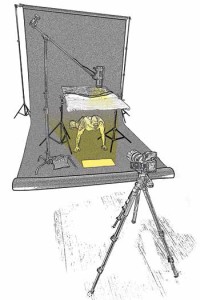articles/Lighting/cwl45bw-page1
Dave Montizambert Creating with Light Part 45 Black and White - part 1 of 1 2
by Dave Montizambert Published 01/04/2017

1
I believe photography is a beautiful abstraction of reality and that black and white (B&W) is even more so. With proper care and attention, B&W is beautiful, artful, but if you intend to create something more than the mediocre, there is much more to consider than simply applying a mono-chromatic conversion to a digital image capture. There is an infinite number of ways to create B&W; I give lighting and processing equal consideration as both are absolutely key to great mono-chromatic images.
First off photography is all about light and B&W photography is no different. Lighting for monochromatic imagery offers more freedom in the highlight end of the tonal scale than does lighting for colour imagery. Generally speaking, in B&W the highlights can be pushed higher up in the grey scale than you can in colour. Think of a fashion image in B&W where the model’s facial flesh is or is almost burned out to white. This same image in colour may not be so appealing; burned out areas of flesh in colour can make the subject look oily or greasy. Photographers have always loved lighting black flesh-tones. Generally, you shape lightertoned faces and bodies predominantly with shadow and to a much lesser degree with specular (shine, sheen). With darker flesh-tones you rely more heavily on specular and way less on shadow.

2
When I say specular I’m referring to specular highlights which are mirror images or reflections of a source of illumination imaging on the surface of your subject. This bright shine sitting on the surface of your subject makes for a dramatic contrast on darker-toned subjects and less so on lighter ones. This is why lighting dark flesh is so loved by photographers since they get to play with this specular light-form. When I was originally learning lighting back in the early 1980s, there were not that many darkskinned people to light and photograph in my home town Vancouver BC. I loved the artful figure studies that I saw of dark skinned models. I wanted to try this out but alas with no dark flesh at hand I had to get a little tricky. Knowing that the brightness of a specular highlight (called specular contrast in tech-speak), can be controlled independently from the brightness of the subject’s true tone, (called diffused value in techspeak), it occurred to me that I could turn a light person into a dark person by simply underexposing them and then showing all their shape and form by creating bright sheen or specular highlights over their face and body. I recently used this technique on an image of kick-boxer, Michael Donnellan (see image 001), from my ‘Dances With One Light – Dramatic Illumination Techniques’ lighting tutorial DVD.
You are currently on page 1
- Dave Montizambert Creating with Light Part 45 Black and White page 1
- Dave Montizambert Creating with Light Part 45 Black and White page 2
1st Published 01/04/2017
last update 09/12/2022 14:53:03
More Lighting Articles
There are 0 days to get ready for The Society of Photographers Convention and Trade Show at The Novotel London West, Hammersmith ...
which starts on Wednesday 15th January 2025





